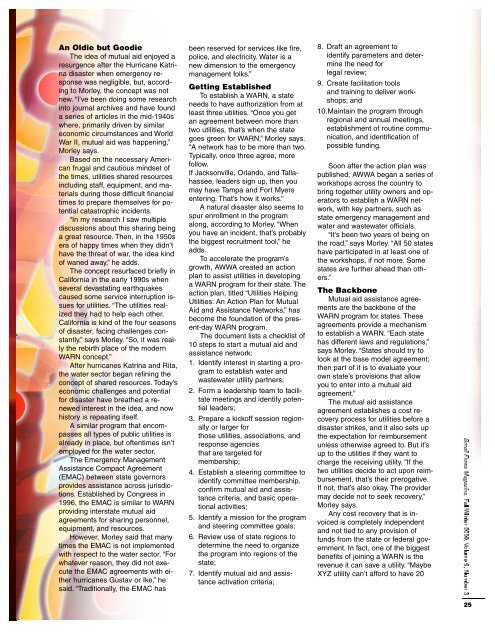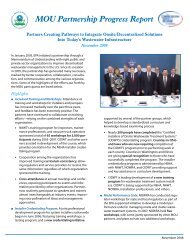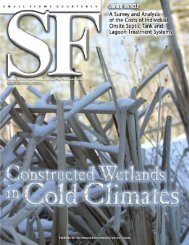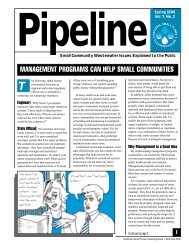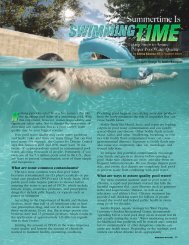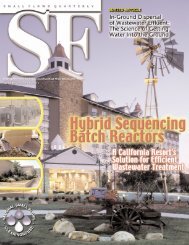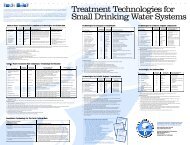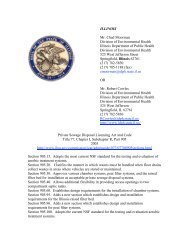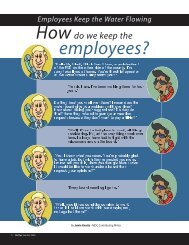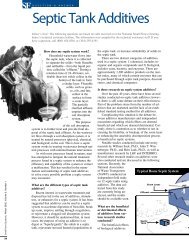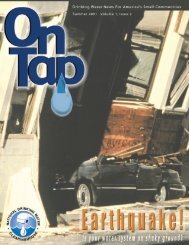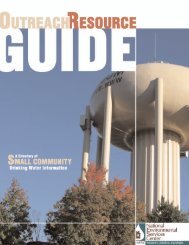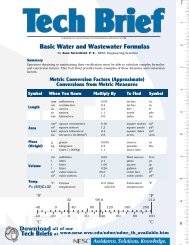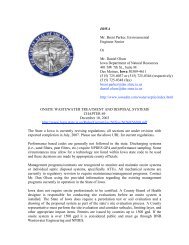Craig Mains | Technical Assistant - National Environmental Services ...
Craig Mains | Technical Assistant - National Environmental Services ...
Craig Mains | Technical Assistant - National Environmental Services ...
You also want an ePaper? Increase the reach of your titles
YUMPU automatically turns print PDFs into web optimized ePapers that Google loves.
An Oldie but Goodie<br />
The idea of mutual aid enjoyed a<br />
resurgence after the Hurricane Katrina<br />
disaster when emergency response<br />
was negligible, but, according<br />
to Morley, the concept was not<br />
new. “I’ve been doing some research<br />
into journal archives and have found<br />
a series of articles in the mid-1940s<br />
where, primarily driven by similar<br />
economic circumstances and World<br />
War II, mutual aid was happening,”<br />
Morley says.<br />
Based on the necessary American<br />
frugal and cautious mindset of<br />
the times, utilities shared resources<br />
including staff, equipment, and materials<br />
during those difficult financial<br />
times to prepare themselves for potential<br />
catastrophic incidents.<br />
“In my research I saw multiple<br />
discussions about this sharing being<br />
a great resource. Then, in the 1950s<br />
era of happy times when they didn’t<br />
have the threat of war, the idea kind<br />
of waned away,” he adds.<br />
The concept resurfaced briefly in<br />
California in the early 1990s when<br />
several devastating earthquakes<br />
caused some service interruption issues<br />
for utilities. “The utilities realized<br />
they had to help each other.<br />
California is kind of the four seasons<br />
of disaster, facing challenges constantly,”<br />
says Morley. “So, it was really<br />
the rebirth place of the modern<br />
WARN concept.”<br />
After hurricanes Katrina and Rita,<br />
the water sector began refining the<br />
concept of shared resources. Today’s<br />
economic challenges and potential<br />
for disaster have breathed a renewed<br />
interest in the idea, and now<br />
history is repeating itself.<br />
A similar program that encompasses<br />
all types of public utilities is<br />
already in place, but oftentimes isn’t<br />
employed for the water sector.<br />
The Emergency Management<br />
Assistance Compact Agreement<br />
(EMAC) between state governors<br />
provides assistance across jurisdictions.<br />
Established by Congress in<br />
1996, the EMAC is similar to WARN<br />
providing interstate mutual aid<br />
agreements for sharing personnel,<br />
equipment, and resources.<br />
However, Morley said that many<br />
times the EMAC is not implemented<br />
with respect to the water sector. “For<br />
whatever reason, they did not execute<br />
the EMAC agreements with either<br />
hurricanes Gustav or Ike,” he<br />
said. “Traditionally, the EMAC has<br />
been reserved for services like fire,<br />
police, and electricity. Water is a<br />
new dimension to the emergency<br />
management folks.”<br />
Getting Established<br />
To establish a WARN, a state<br />
needs to have authorization from at<br />
least three utilities. “Once you get<br />
an agreement between more than<br />
two utilities, that’s when the state<br />
goes green for WARN,” Morley says.<br />
“A network has to be more than two.<br />
Typically, once three agree, more<br />
follow.<br />
If Jacksonville, Orlando, and Tallahassee,<br />
leaders sign up, then you<br />
may have Tampa and Fort Myers<br />
entering. That’s how it works.”<br />
A natural disaster also seems to<br />
spur enrollment in the program<br />
along, according to Morley. “When<br />
you have an incident, that’s probably<br />
the biggest recruitment tool,” he<br />
adds.<br />
To accelerate the program’s<br />
growth, AWWA created an action<br />
plan to assist utilities in developing<br />
a WARN program for their state. The<br />
action plan, titled “Utilities Helping<br />
Utilities: An Action Plan for Mutual<br />
Aid and Assistance Networks,” has<br />
become the foundation of the present-day<br />
WARN program.<br />
The document lists a checklist of<br />
10 steps to start a mutual aid and<br />
assistance network:<br />
1. Identify interest in starting a program<br />
to establish water and<br />
wastewater utility partners;<br />
2. Form a leadership team to facilitate<br />
meetings and identify potential<br />
leaders;<br />
3. Prepare a kickoff session regionally<br />
or larger for<br />
those utilities, associations, and<br />
response agencies<br />
that are targeted for<br />
membership;<br />
4. Establish a steering committee to<br />
identify committee membership,<br />
confirm mutual aid and assistance<br />
criteria, and basic operational<br />
activities;<br />
5. Identify a mission for the program<br />
and steering committee goals;<br />
6. Review use of state regions to<br />
determine the need to organize<br />
the program into regions of the<br />
state;<br />
7. Identify mutual aid and assistance<br />
activation criteria;<br />
8. Draft an agreement to<br />
identify parameters and determine<br />
the need for<br />
legal review;<br />
9. Create facilitation tools<br />
and training to deliver workshops;<br />
and<br />
10.Maintain the program through<br />
regional and annual meetings,<br />
establishment of routine communication,<br />
and identification of<br />
possible funding.<br />
Soon after the action plan was<br />
published, AWWA began a series of<br />
workshops across the country to<br />
bring together utility owners and operators<br />
to establish a WARN network,<br />
with key partners, such as<br />
state emergency management and<br />
water and wastewater officials.<br />
“It’s been two years of being on<br />
the road,” says Morley. “All 50 states<br />
have participated in at least one of<br />
the workshops, if not more. Some<br />
states are further ahead than others.”<br />
The Backbone<br />
Mutual aid assistance agreements<br />
are the backbone of the<br />
WARN program for states. These<br />
agreements provide a mechanism<br />
to establish a WARN. “Each state<br />
has different laws and regulations,”<br />
says Morley. “States should try to<br />
look at the base model agreement;<br />
then part of it is to evaluate your<br />
own state’s provisions that allow<br />
you to enter into a mutual aid<br />
agreement.”<br />
The mutual aid assistance<br />
agreement establishes a cost recovery<br />
process for utilities before a<br />
disaster strikes, and it also sets up<br />
the expectation for reimbursement<br />
unless otherwise agreed to. But it’s<br />
up to the utilities if they want to<br />
charge the receiving utility. “If the<br />
two utilities decide to act upon reimbursement,<br />
that’s their prerogative.<br />
If not, that’s also okay. The provider<br />
may decide not to seek recovery,”<br />
Morley says.<br />
Any cost recovery that is invoiced<br />
is completely independent<br />
and not tied to any provision of<br />
funds from the state or federal government.<br />
In fact, one of the biggest<br />
benefits of joining a WARN is the<br />
revenue it can save a utility. “Maybe<br />
XYZ utility can’t afford to have 20<br />
25


